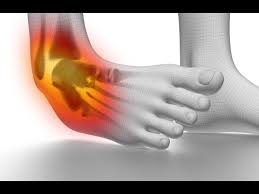Ankle sprains are a common musculoskeletal injury, and are commonly sustained in individuals who participate in sport. These injuries more often present on the outside of the foot from force through an excessively inverted or externally rotated foot. In other words, landing on a bent or twisted foot. These injuries are graded according to the extend of damage in the lateral ligaments as 1, 2 or 3 ankle sprain;
Grade 1 sprain
Grade 1 is a mild ankle sprain, involving an overstretch of lateral ligaments, but no tearing. Symptoms include mild pain and swelling, mild joint stiffness and instability, and discomfort running or jumping.
Grade 2 sprain
Grade 2 is classed as a moderate sprain or microligament lesion, where there is a partial tear of the ligament. Symptoms include moderate to high levels of swelling and bruising, moderate pain, loss of ankle movement and difficulty walking.
Grade 3 sprain
Grade 3 is the most severe type of ankle sprain, involving a full tear of lateral ligaments. Symptoms are described as severe swelling and pain, instability of the joint, extreme loss of ankle movement, and significant pain on walking.
Sprains usually heal on their own, with pain decreasing rapidly in the first two weeks after injury. However, if not rested or treated appropriately, symptoms can be prolonged or never returned to a pre-injury state. Symptoms include chronic ankle instability or giving way, persistent pain, swelling, recurrent injury, impingement and joint degeneration.
How to treat an ankle sprain
The longstanding recommendations for an acute ankle sprain is the ‘RICER’ protocol, standing for Rest, Ice, Compression, Elevation and Rehabilitation. Recently this protocol has been investigated and studied in order to find the most efficient and effective management of acute ankle sprains. From the literature, the following recommendations can now be applied;
- RICER alone is not effective; an appropriate and specific assessment and rehabilitation is required to gain 100% ankle function post injury.
- Non steroidal anti-inflammatory drugs (anti-inflammatories) may suppress the natural healing process; reducing the inflammatory process needed for healing
- Ice and cryotherapy in combination with exercise has a greater effect on reducing swelling compared with heat. The cold results in significant improvements in ankle function in short term, allowing increased loading during weight bearing and walking compared to functional treatment alone.
- There is added value from a short period of immobilisation (maximum of 10days) in rigid support. Followed by functional support in a brace for 4-6weeks to decrease pain and oedema, and improve functional outcomes.
- Loading and strengthening the ankle in a protected manner, by a supervised program. This can improve strength, proprioception (awareness), returning to work and sport.
- There is added value of manual mobilisation with exercise, than just exercise alone. Manual mobilisation an be delivered by a therapist or by using various equipment to increase ankle joint range.
- Functional treatment is still preferred over surgery, having similar outcomes in ankle function. However, when taking individual decisions into account, there is a quicker return to sport after surgical interventions. Also considered if exercise and conservative rehabilitation is ineffective.
- Braces should be worm for recurrent incidents
In terms of prevention, previously injured ankles should be taped for support when performing impactful activities, such as running, jumping or sport. Strength, stability and proprioceptive exercises should be ongoing to provide the continual support needed to the surrounding ankle structures. These exercises are specific to the injury sustained, and provided by a health professional.
Needing your ankle assessed by a Physiotherapy professional, Begin Here



